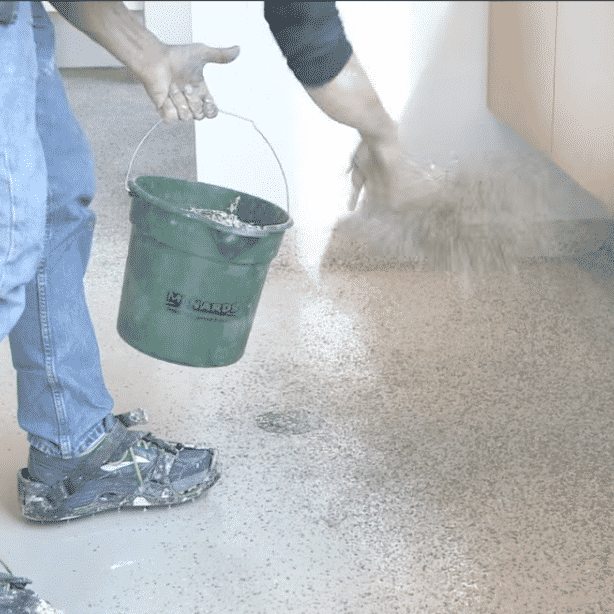Troubleshooting Guide: Handling Common Issues with Epoxy Floor Coatings
December 20th, 2023 | 3 min. read

Epoxy floor coatings are a popular choice for homeowners and businesses seeking all the following floor solutions:
- Durable
- Cost-effective
- Low maintenance
- Sleek and polished appearance
These attributes make epoxy coatings ideal for garages, warehouses, commercial spaces, and residential interiors. However, like any flooring material, epoxy coatings come with their own set of challenges and common issues that need to be addressed.
At Floor Shield, we have our own line of epoxy floor coatings and are often asked, “What are the drawbacks of using epoxies?” and “How do I account for those downsides?” We’ll answer these and related questions honestly and give you a transparent view of what you need to look out for when using an epoxy coating system.
What Causes Epoxy to Delaminate?
Epoxy coatings, while renowned for their strength, are more susceptible to flaking and peeling compared to other coating options, such as polyaspartic coatings. The phenomenon of delamination occurs when the epoxy layer separates from the concrete substrate, often due to poor surface preparation or improper installation techniques.
It's crucial to ensure the surface is thoroughly cleaned and profiled so that it is free of contaminants before applying epoxy coatings. To best avoid early flaking and peeling, hiring experienced professionals will exponentially reduce the risk of flaking and peeling issues, as they are:
- Trained
- Have experience
- Will follow the best practices
Can Epoxy be Slip-Resistant?
Another common concern with epoxy floor coatings is their relatively limited slip resistance. Epoxy surfaces can be slippery when wet, posing safety hazards, especially in areas prone to spills or moisture. To address this issue, installers often incorporate aggregates, such as silica, into the epoxy mixture. These aggregates create a textured surface that is safer for occupants.
How Long Does It Take Epoxy to Cure?
Epoxy coatings have a lengthy drying and curing process, typically requiring a two-day return to service. This long curing time can pose challenges for businesses that cannot afford to shut down their operations for an extended period.
To mitigate this issue, some businesses opt for a phased approach, sectioning off areas of their location to coat one part of the floor at a time. While this method can help maintain business continuity, it may result in visible transition lines between coated and uncoated areas.
The key to avoiding transition line issues lies in hiring experienced installers who can seamlessly blend the coated sections to achieve a uniform finish. You’ll have to schedule your local installer before or after business hours or alter them to avoid disruptions to your daily operations.
How Cold is Too Cold for Epoxy?
One of the primary issues with epoxy floor coatings is their sensitivity to temperature. Epoxy resins require a minimum temperature of 50 degrees Fahrenheit or above to cure properly. In cold weather conditions, this can pose a significant challenge, as epoxy may not cure correctly, leading to compromised adhesion and durability.
To combat this issue, in smaller spaces like garages, some installers resort to placing heaters around the workspace to artificially raise the temperature for the installation process.
Alternatively, a more robust solution comes in the form of Floor Shield's 100% polyaspartic coating. Unlike traditional epoxy, our coating can cure effectively in temperatures as low as 0 degrees Fahrenheit. This means that in most cases, you won’t have to wait for warmer weather to get your floor coated.
How Do You Make Epoxy UV Stable?
Epoxy coatings are not UV stable, which means they are prone to ambering and fading when exposed to frequent sunlight. This can be a significant concern for outdoor applications or areas with large windows that allow ample sunlight to reach the floor.
To counteract the effects of UV exposure, installers can apply UV stabilizer topcoats over the epoxy finish. These topcoats act as a protective barrier, preserving the color and integrity of the epoxy layer for far longer. UV-stable topcoats will extend the lifespan of the epoxy floor’s vibrance.
Epoxy floor coatings, while a popular choice for their durability and aesthetic appeal, do come with their fair share of challenges such as:
- Temperature sensitivity
- Flaking
- Limited slip resistance
- Lengthy curing times
- Lack of UV stability
These inherent drawbacks make it essential to hire trained professionals to mitigate problems and, in some cases, the use of alternative coating solutions like polyaspartic products.
For information on the cost of epoxy coatings, check out this article.
Floor Shield offers a 100% polyaspartic coating proven by third-party testing to be overall superior to epoxies. Scroll down to get a free, no-obligation quote.
